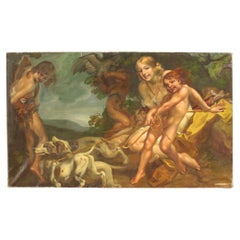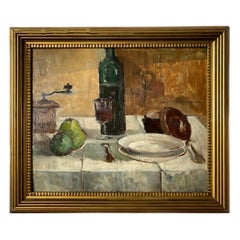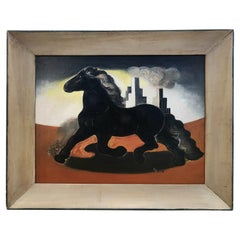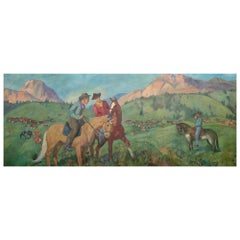Canvas Paintings
10
to
6
3
10
10
10
2
1
76
84
274
126
40
125
78
2
4
10
10
8
17
35
25
10
11
10
10
8
6
4
8
3
3
2
2
1
Period: 1930s
Material: Canvas
20th Century Oil on Canvas Italian Mythological Painting Diana the Huntress 1930
Located in Vicoforte, Piedmont
Italian painting from the first half of the 20th century. Framework oil on canvas depicting mythological subject Diana the Huntress of excellent pictorial quality. Painting of great ...
Category
1930s Italian Vintage Canvas Paintings
Materials
Canvas
20th Century Oil on Canvas Italian Portrait Painting Signed Garino Dated 1931
Located in Vicoforte, Piedmont
Italian painting dated July 1931. Oil on canvas artwork depicting a portrait of a gentleman with a typical bearing and dress of the 1920s/30s. Painting adorned with a sumptuous and e...
Category
1930s Italian Vintage Canvas Paintings
Materials
Canvas
20th Century Oil on Canvas Italian Signed Angelo Garino Painting Lady Portrait
Located in Vicoforte, Piedmont
Italian painting dated August 1931. Oil on canvas depicting a portrait of a woman with a bright dress typical of the 1920s/30s. Painting adorned with a sumptuous and elegant wooden f...
Category
1930s Italian Vintage Canvas Paintings
Materials
Canvas
1930s cubist still life from Paris
Located in DARLINGTON, WA
1930/ signed cubist still life painting
Category
1930s French French Provincial Vintage Canvas Paintings
Materials
Canvas
Eduard Buk Ulreich Black Runner 1933
Located in Hudson, NY
Oil on canvas by American artist Eduard Buk Ulreich. Signed and dated 1933. Retaining the original artists frame. Few of his oil paintings survive as most of what you find are water ...
Category
1930s American Art Deco Vintage Canvas Paintings
Materials
Canvas, Paint
C1930 Impressionist Ashcan Original Painting of a Cafe Scene Oil on Canvas
Located in Port Jervis, NY
Impressionist view of a interior cafe with a chef and patrons. Colorful palette with a Ashcan style in the Painting created about 1930. Unsigned. Framed in what appears to be the ori...
Category
1930s American Modern Vintage Canvas Paintings
Materials
Canvas, Hardwood, Paint
Gemälde "Mädchen am Bach" Öl auf Leinwand Signatur: Ludwig, 1933
Located in Mainz, DE
Schönes Ölgemälde auf Leinwand. Es zeigt ein unter einer Birke sitzendes Mädchen am Bach. Das Bild ist mit wunderschöner Perspektive und Bokeh. Die Farben sind kräftig und eignen si...
Category
1930s German Country Vintage Canvas Paintings
Materials
Canvas
Jean Bonnardel Portrait by Federico Masses
Located in New York, US
Our very large portrait of Jean Bonnardel (1899-1952), Countess Madeleine de Montgomery, by Federico Armando Beltran Masses (1885-1949) measures 77 3/8 ...
Category
1930s French Art Deco Vintage Canvas Paintings
Materials
Canvas
20th Century French Still-Life Oil on Canvas Signed Roux-Abougit, 1930s
Located in LEGNY, FR
Very nice 20th century French still-life oil on canvas Signed roux abougit from the 1930s.
Roux-abougit is a French painter from Lyon (south-east of France).
This painting represen...
Category
1930s French Vintage Canvas Paintings
Materials
Canvas
E. C. Ulnitz Pink Roses, Signed and Dated E. C. Ulnitz 1930, Oil on Canvas
Located in Virum, DK
E. C. Ulnitz: pink roses. Signed and dated E. C. Ulnitz 1930. Oil on canvas. Measures: 27 × 21 cm. Europe, Denmark.
Category
1930s Danish Vintage Canvas Paintings
Materials
Canvas
Related Items
Large Hand Painted Oil on Canvas Painting of Arab Street Scene Signed Hassan
Located in Lisse, NL
Large size and slightly abstract Arab street scene painting.
This larger size and very well executed painting is another one of our recent great finds. It may be abstract in style, ...
Category
Mid-20th Century Unknown Islamic Canvas Paintings
Materials
Linen, Plaster, Wood, Paint, Canvas
Free Shipping
H 33 in W 41.2 in D 3.7 in
20th Century Signed Chamberlain Oil Painting of a Cow
Located in Los Angeles, CA
20th century oil painting of a cow peaking out of the barn door. This oil on canvas is signed Chamberlain and newly frame.
Category
Mid-20th Century American Country Canvas Paintings
Materials
Wood
20th Century German Modernist Oil Painting - Three Figures
Located in Cirencester, GB
Artist: Elisabeth Hahn (German 1924-2021),
Elisabeth Hahn was born in Dortmund, Germany, where she began her artistic studies. In 1953, she moved to Paris. She continued her stud...
Category
Mid-20th Century Canvas Paintings
Materials
Other
Surrealistic Oil Painting on Canvas, 1970
Located in Antwerp, BE
Vintage framed oil painting on canvas, 1970. Depicts a woman with pill, standing in a moonlit landscape. Signed with R.Boutens, 70.
Dimensions: 108 W x 88 H x 3.5 D cm.
Category
1970s Belgian Space Age Vintage Canvas Paintings
Materials
Canvas, Paint
Well Executed Modern Industrialist Oil Painting Futuristic Factory Workers
Located in Buffalo, NY
Well executed modern industrialist oil painting, futuristic factory workers. Amazing use of color, texture and space. Artist unknown. Mark Kostabi meets Fernand Leger.
Category
Mid-20th Century American Art Deco Canvas Paintings
Materials
Masonite, Paint
Painting Cattle Carriage on an Alpine Lake, Oil on Canvas 19th century
Located in Berghuelen, DE
Painting Cattle Carriage on an Alpine Lake, Oil on Canvas 19th century
A lovely antique oil painting depicting a Tyrolian farmers family which loads their cattle heard onto a boat. The scene is located on an mountain lake in the Alpine landscape. Oil on canvas 1st half of the 19th century. Framed with vintage gilded frame, paint partly with craquelure. This painting will be a highlight in each rural decoration.
Alpine oil painting...
Category
Late 19th Century German Biedermeier Antique Canvas Paintings
Materials
Wood, Canvas
H 19.3 in W 22.05 in D 1.78 in
Oil on Canvas of Diana, Goddess of the Hunt
Located in Palm Beach, FL
Oil on canvas of the classical figure Diana holding a bow in a landscape setting with a putti and dogs in vivid colors.
French School
18th century
Category
18th Century European Baroque Antique Canvas Paintings
Materials
Canvas
Black White Arizona Desert Mountain Landscape Signed Oil Painting, Edwin H House
Located in Studio City, CA
A lovely gem of an impressionist Arizona landscape oil on board painting by Brisbee, Arizona artist Edwin H House.
The painting is done in subtle s...
Category
20th Century American Modern Canvas Paintings
Materials
Paint
H 9.6 in W 11.5 in D 1.75 in
19th Century Folk Art Painting of a Gentleman Attributed to Horace Bundy
Located in Wiscasset, ME
Oil on canvas, inscribed on the stretcher bar reverse.
The painting is presented in a flat black frame that complements it well.
Horace Bundy was an it...
Category
1830s American Folk Art Antique Canvas Paintings
Materials
Canvas, Paint
Mid Century French Post-Impressionist Painting, Black & White Figure Scene
Located in Cirencester, GB
Landscape
Signed by Édouard Righetti (1924-2001)
Inscribed Verso on back
oil/gouache painting on thin artist paper, beautifully painted.
very good condition
size: 21 x inches ...
Category
Mid-19th Century Antique Canvas Paintings
Materials
Other
Cubist Still Life "Violin" by Agnes Weinrich, Signed, Dated 1922
By Agnes Weinrich
Located in New York, NY
Still life painting (Violin, Flowers), Oil on canvas, by Agnes Weinrich, Signed and dated "22", Unframed: 20" x 16", Framed 27.5 x 23".
Agnes Weinrich (1873-1946) was an early female, American modernist artist at a time when there was little interest in Modern Art in the USA and when few women were artists. She was a ground breaker in modern art. The painting shown is an important example of her mature phase of her work.
A biography from Wiki-pedia follows:
Agnes Weinrich (1873–1946) was one of the first American artists to make works of art that were modernist, abstract, and influenced by the Cubist style. She was also an energetic and effective proponent of modernist art in America, joining with like-minded others to promote experimentation as an alternative to the generally conservative art of their time.
Early years[edit]
Agnes Weinrich was born in 1873 on a prosperous farm in south east Iowa. Both her father and mother were German immigrants and German was the language spoken at home. Following her mother's death in 1879 she was raised by her father, Christian Weinrich. In 1894, at the age of 59, he retired from farming and moved his household, including his three youngest children—Christian Jr. (24), Agnes (21), and Lena (17), to nearby Burlington, Iowa, where Agnes attended the Burlington Collegiate Institute from which she graduated in 1897.[1][2][3] Christian took Agnes and Lena with him on a trip to Germany in 1899 to reestablish links with their German relatives. When he returned home later that year, he left the two women in Berlin with some of these relatives, and when, soon after his return, he died, they inherited sufficient wealth to live independently for the rest of their lives.
Either before or during their trip to Germany Lena had decided to become a musician and while in Berlin studied piano at the Stern Conservatory. On her part, Agnes had determined to be an artist and began studies toward that end at the same time.[1][4] In 1904 the two returned from Berlin and settled for two years in Springfield, Illinois, where Lena taught piano in public schools and Agnes painted in a rented studio. At this time Lena changed her name to Helen. In 1905 they moved to Chicago where Agnes studied at the School of the Art Institute of Chicago under John Vanderpoel, Nellie Walker, and others.[1]
In 1909 Agnes and Helen returned to Berlin and traveled from there to Munich, where Agnes studied briefly under Julius Exter, and on to Rome, Florence, and Venice before returning to Chicago.[5] They traveled to Europe for the third, and last, time in 1913, spending a year in Paris. There, they made friends with American artists and musicians who had gathered there around the local art scene. Throughout this period, the work Agnes produced was skillful but unoriginal—drawings, etching, and paintings in the dominant academic and impressionist styles.[1]
On her return from Europe in 1914, she continued to study art, during the warm months of the year in Provincetown, Massachusetts,[1] where she was a member of the Provincetown Printers art colony in Massachusetts,[6] and during the colder ones in New York City. In Provincetown she attended classes at Charles Hawthorne's Cape Cod School of Art and in New York, the Art Students League.[1]
Drawing of an old woman by Agnes Weinrich, graphite on paper, 11.5 x 7.5 inches.
Hawthorne and other artists established the Provincetown Art Association in 1914 and held the first of many juried exhibitions the following year. Weinrich contributed nine pictures to this show, all of them representational and somewhat conservative in style.[1]
A pencil sketch made about 1915 shows a figure, probably one of the Portuguese women of Provincetown. Weinrich was a metculous draftsperson and this drawing is typical of the work she did in the academic style between 1914 and 1920. She also produced works more akin to the Impressionist favored by Hawthorne and many of his students. When in 1917 Weinrich showed paintings in a New York women's club, the MacDowell Club, the art critic for the Brooklyn Daily Eagle said they showed a "strong note of impressionism."[7]
Broken Fence by Agnes Weinrich, a white-line woodblock made on or before 1917; at left: the woodblock itself; at right: a print pulled from the woodblook.
In 1916 Weinrich joined a group of printmakers which had begun using the white-line technique pioneered by Provincetown artist B.J.O. Nordfelt. She and the others in the group, including Blanche Lazzell, Ethel Mars and Edna Boies Hopkins, worked together, exchanging ideas and solving problems.[1][8] A year later Weinrich showed one of her first white-line prints at an exhibition held by the Pennsylvania Academy of Fine Arts in Philadelphia.[9]
Broken Fence, in its two states—the print and the woodblock from which she made it—show Weinrich to be moving away from realistic presentation, towards a style, which, while neither abstract, nor Cubist, brings the viewer's attention to the flat surface plane of the work with its juxtaposed shapes and blocks of contrasting colors.
Cows Grazing in the Dunes near Provincetown by Agnes Weinrich, white-line woodcut, 10 x 10 1/2 inches
When in 1920 the informal white-line printmakers' group organized its own exhibition, Weinrich showed a dozen works, including one called Cows Grazing in the Dunes near Provincetown. This print shows greater tendency to abstraction than eitherBroken Fence or the prints made by other Provincetown artists of the time. The cows and dunes are recognizable but not presented realistically. The white lines serve to emphasize the blocks of muted colors which are the print's main pictorial elements. Weinrich uses the texture of the wood surface to call attention to the two-dimensional plane—the paper on which she made the print—in contrast with the implicit depth of foreground and background of cows, dunes, and sky. While the work is not Cubist, it has a proto-Cubist feel in a way that is similar to some of the more abstract paintings of Paul Cézanne.[10]
By 1919 or 1920, while still spending winters in Manhattan and summers on Cape Cod, the sisters came to consider Provincetown their formal place of residence.[1][11][12][13] By that time they had also met the painter, Karl Knaths. Like themselves a Midwesterner of German origin who had grown up in a household where German was spoken, he settled in Provincetown in 1919. Agnes and Knaths shared artistic leanings and mutually influenced each other's increasing use of abstraction in their work.[1][14]
The sisters and Knaths became close companions. In 1922 Knaths married Helen and moved into the house which the sisters had rented. He was then 31, Helen 46, and Agnes 49 years old. When, two years later, the three decided to become year-round residents of Provincetown, Agnes and Helen used a part of their inheritance to buy land and materials for constructing a house and outbuildings for the three of them to share. Knaths himself acquired disused structures nearby as sources of lumber and, having once been employed as a set building for a theater company, he was able to build their new home.[15]
Weinrich was somewhat in advance of Knaths in adopting a modernist style. She had seen avant-garde art while in Paris and met American artists who had begun to appreciate it. On her return to the United States she continued to discuss new theories and techniques with artists in New York and Provincetown, some of whom she had met in Paris. This loosely-knit group influenced one another as their individual styles evolved. In addition to Blance Lazzell, already mentioned, the group included Maude Squires, William Zorach, Oliver Chaffee, and Ambrose Webster. Some of them, including Lazzell and Flora Schofield had studied with influential modernists in Paris and most had read and discussed the influential Cubist and Futurist writings of Albert Gleizes and Gino Severini.[16][17]
Mature style[edit]
Woman with Flowers by Agnes Weinrich, circa 1920, oil on canvas, 34 x 30 1/4 inches, exhibited at the Provincetown Art Association exhibition of 1920, made available courtesy of the Association.
Two of Weinrich's paintings, both produced about 1920, mark the emergence of her mature style. The first, Woman With Flowers, is similar to one by the French artist, Jean Metzinger called Le goûter (Tea Time) (1911).[18]
Red Houses by Agnes Weinrich, circa 1921, oil on canvas on board, 24.25 x 25.5 inches; exhibited "Red Houses" at Fifth Annual Exhibition of the Society of Independent Artists.
Like much of Metzinger's work, Le goûter was discussed in books and journals of the time—including one called Cubism co-authored by Metzinger himself.[19] Because the group with which Weinrich associated read about and discussed avant-garde art in general and Cubism in particular, it is reasonably likely that Weinrich was familiar with Metzinger's work before she began her own.
The second painting, Red Houses, bears general similarity to landscapes by Cézanne and Braque. Both paintings are Cubist in style. However, with them Weinrich did not announce an abrupt conversion to Cubism, but rather marked a turning toward greater experimentation. In her later work she would not adopt a single style or stylistic tendency, but would produce both representative pictures and ones that were entirely abstract, always showing a strong sense of the two-dimensional plane of the picture's surface. After she made these two paintings neither her subject matter nor the media she used would dramatically change. She continued to employ subjects available to her in her Provincetown studio and the surrounding area to produce still lifes, village and pastoral scenes, portraits, and abstractions in oil on canvas and board; watercolor, pastel, crayon and graphite on paper; and woodblock prints.[20]
Possessing an outgoing and engaging personality and an active, vigorous approach to life, Weinrich promoted her own work while also helping Karl Knaths to develop relationships with potential patrons, gallery owners, and people responsible for organizing exhibitions. With him, she put herself in the forefront of an informal movement toward experimentation in American art. Since, because of her independent means, she was not constrained to make her living by selling art, she was free to use exhibitions and her many contacts with artists and collectors to advance appreciation and understanding of works which did not conform to the still-conservative norm of the 1920s and 1930s.[1][21][22]
Early in the 1920s, critics began to take notice of her work, recognizing her departure from the realism then prevailing in galleries and exhibitions. Paintings that she showed in 1922 drew the somewhat dry characterization of "individualistic.",[23] and in 1923 her work drew praise from a critic as "abstract, but at the same time not without emotion."[24]
In 1925 Weinrich became a founding member of the New York Society of Women Artists. Other Provincetown members included Blanche Lazzell, Ellen Ravenscroft, Lucy L'Engle, and Marguerite Zorach. The membership was limited to 30 painters and sculptors all of whom could participate in the group's exhibitions, each getting the same space.[23][25][26] The group provided a platform for their members to distinguish themselves from the genteel and traditionalist art that women artists were at that time expected to show[27] and, by the account of a few critics, it appears their exhibitions achieved this goal.[1][28][29][30]
In 1926 Weinrich joined with Knaths and other local artists in a rebellion against the "traditional" group that had dominated the Provincetown Art Association. For the next decade, 1927 through 1937, the association would mount two separate annual exhibitions, the one conservative in orientation and the other experimental, or, as it was said, radical.[31][32] Both Weinrich and Knaths participated on the jury that selected works for the first modernist exhibition.[11]
Still Life by Agnes Weinrich, circa 1926, oil on canvas, 17 x 22 inches. Permission to use granted by Christine M. McCarthy, Executive Director, Provincetown Art Association and Museum. The painting was the gift of Warren Cresswell.
Weinrich's painting, Still Life, made about 1926, may have been shown in the 1927 show. Representative of some aspects of her mature style, it is modernist but does not show Cubist influence. The objects pictured are entirely recognizable, but treated abstractly. Although fore- and background are distinguishable, the objects, as colored forms, make an interesting and visually satisfying surface design.
In 1930 Weinrich put together a group show for modernists at the GRD Gallery in New York. The occasion was the first time a group of Provincetown artists exhibited together in New York. For it she selected works by Knaths, Charles Demuth, Oliver Chaffee, Margarite and William Zorach, Jack Tworkov, Janice Biala, Niles Spencer, E. Ambrose Webster, and others.[1][23]
Later years[edit]
Weinrich turned 60 on July 16, 1933. Although she had led a full and productive life devoted to development of her own art and to the advancement of modernism in art, she did not cease to work toward both objectives. She continued to work in oil on canvas and board, pastel and crayon on paper, and woodblock printing. Her output continued to vary in subject matter and treatment. For example, Still Life with Leaves, circa 1930 (oil on canvas, 18 x 24 inches) contains panels of contrasting colors with outlining similar to Knaths's style. Movement in C Minor, circa 1932 (oil on board, 9 x 12 inches) is entirely abstract. It too relates to Knaths's work, both in treatment (again, outlined panels of contrasting colors) and in its apparent relationship to music, something in which Knaths was also interested. Fish Shacks...
Category
Early 20th Century American Modern Canvas Paintings
Materials
Paint, Canvas
20th Century German Modernist Oil Painting, Figure
Located in Cirencester, GB
Artist: Elisabeth Hahn (German 1924-2021),
Elisabeth Hahn was born in Dortmund, Germany, where she began her artistic studies. In 1953, she moved to Paris. She continued her stud...
Category
Mid-20th Century Canvas Paintings
Materials
Other
Previously Available Items
WPA Mural, "Americans at Work" by John M. Heller, circa 1935
By John M. Heller
Located in Culver City, CA
Large-scale oil on canvas painting depicting cowboys attending cattle. Six murals were made in total portraying idealized scenes of the American industry in progress. The paintings l...
Category
1930s American Vintage Canvas Paintings
Materials
Canvas, Paint
Juvisy Sur Orge Par Temps Gris
By Jules Emile Bourg
Located in Forest Row, East Sussex
Juvisy sur Orges par Temps Gris', an Art Deco oil on canvas landscape of a view across a river on a Wintery day. Signed Bourg to lower left.
Exhibited Paris 1931 Salon, Société Nati...
Category
1930s French Art Deco Vintage Canvas Paintings
Materials
Canvas
Gio Colucci "Femme Assise, " circa 1930
By Gio Colucci
Located in Saint-Ouen, FR
Gio Colucci (Italian 1894-1974).
"Femme assise"
Oil on canvas,
circa 1930.
Signed.
The measurements are without the frame.
Category
1930s European Vintage Canvas Paintings
Materials
Canvas
Collection of Fernando Botero Understudy Paintings
By Fernando Botero
Located in Los Angeles, CA
Fantastic collection of three unsigned paintings look like Fernando Botrero possibly and understudy of Botero. These are made on old stretched canvas and are in good condition.
Meas...
Category
1930s American Folk Art Vintage Canvas Paintings
Materials
Canvas
Hand-Painted Carnival Banner
Located in Chicago, IL
Hand painted c. 1930 American carnival banner on stretcher from a peep-show.
Category
1930s American Vintage Canvas Paintings
Materials
Canvas, Paint
Monumental Signed and Dated 1939 Russell Dale Moffett Mural Painting
By Russell Dale Moffett
Located in Los Angeles, CA
Monumental signed and dated 1939 Russell Dale Moffett Mural painting. This is one of two fantastic oil paintings. They are both signed and dated in the...
Category
1930s American Vintage Canvas Paintings
Materials
Wood, Canvas
The Riveter: 1939 Oil Painting by WPA Muralist
Located in Philadelphia, PA
This iconic image of a Depression-era riveter high atop an Art Deco skyscraper was painted by Vincent Maragliotti, one of the most prolific muralists of his day. No doubt created in...
Category
1930s American Vintage Canvas Paintings
Materials
Canvas
Recently Viewed
View AllMore Ways To Browse
Antique Large Mahogany Chest Of Drawers
Antique White Paint For Cabinets
Green Metal Cabinet
Vintage Danish Dresser
Single Wardrobe
Antique Louis Xvi Commode
English Bow Front
Metal Cabinet Green
Painted Retro Dresser
Victorian Ormolu Mounted
European Hand Painted Cabinet
Chippendale Furniture Hardware
Small Floor Cabinet
Contemporary Storage Unit
English Lacquered Cabinet
Tall Metal Cabinet
Vintage Walnut Cupboard
French Marble Top Commode Inlaid







